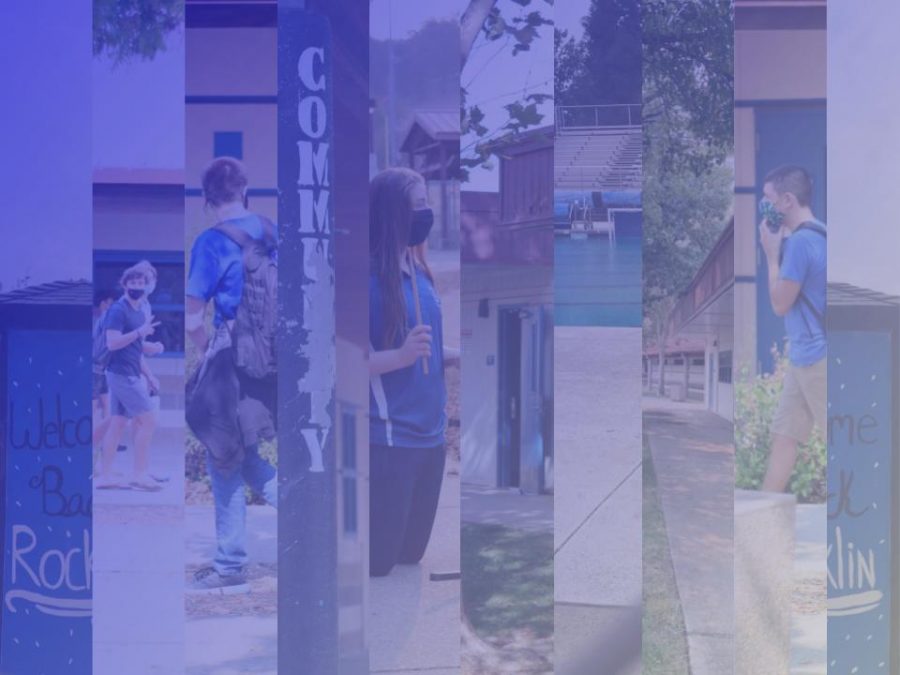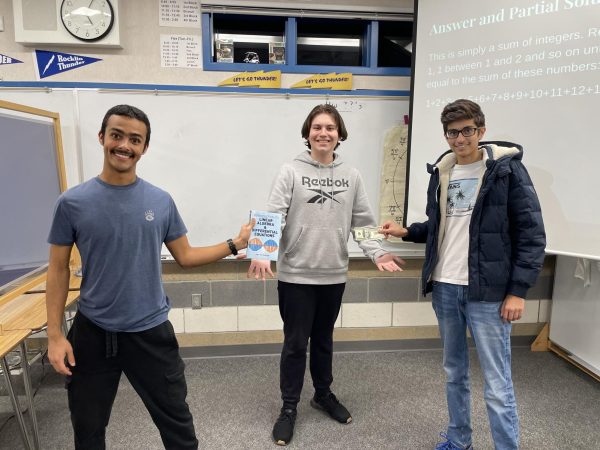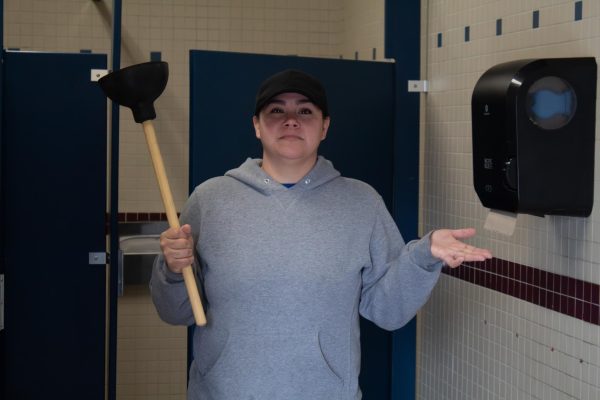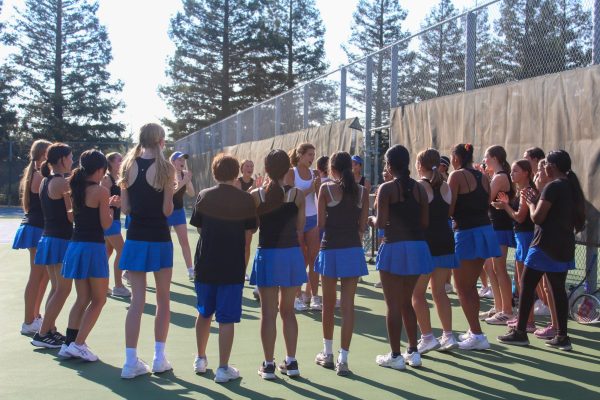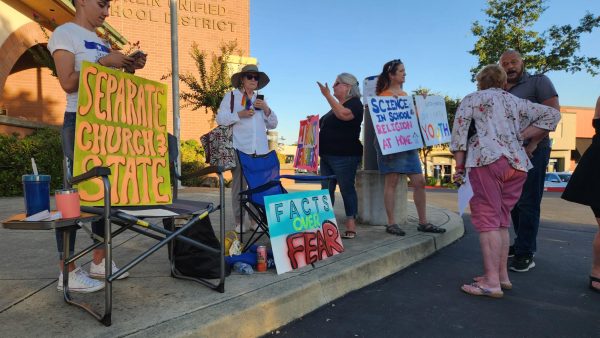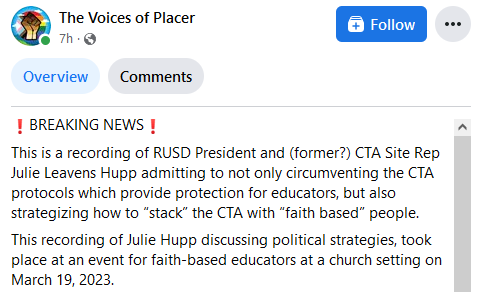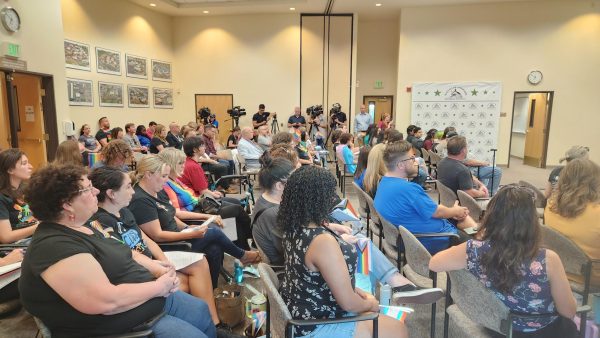1 Controversy – 10 Voices
The Rocklin Unified School District Board holds an eight-and-a-half hour meeting to decide the fate of the remaining 2020-2021 school year.
On December 14, 2020, the Rocklin Unified School District (RUSD) Board of Trustees voted on the model for the remainder of the school year, and decided on the five-day-a-week AM/PM hybrid model for schools in the district.
This model has students attending school five days a week, in two separate groups to reduce the number of students on campus at one time. Class periods would be 40 minutes long, and there would be two 20 minute grab-and-go lunch periods in between the two groups’ times on campus. Although the two groups are planned to remain separate, there is a chance of overlap during the 40 minute transition period between the two cohorts.
For Rocklin High School (RHS) students, this presents the third transition to a new schedule in the five months they’ve been in school. It also guarantees another transition later in the year to a five day, full-time schedule. This five day, full-time schedule is planned to begin after the spring break at the beginning of the high school’s last term, April 6th.
The Flash’s goal as a publication is to give the public a voice, so below are the opinions and feelings of ten RHS administrators, teachers and students. While the voices of the parents that will be affected deserve to be acknowledged, this article is aimed at giving a general feeling of what people on RUSD high school campuses are thinking about the AM/PM hybrid model and schedule.
RHS junior, Sandra Butrous feels like this change is better than going five days, full-time because it allows for social distancing and half the students on campus at once, but “I think that going five days a week compared to two to three times a week on a hybrid schedule is going to be a bit more risky, because you’re going to be more exposed when you’re going full time… My family would rather we stay in the hybrid schedule we’re in right now with the A/B days.”
With the meaning of safety being so relative to each person, Sandra defines her idea of safety at school right now as, “Safety requires everybody wearing masks, being socially distanced from everybody else (not closer than six feet away) and being careful of the people you surround yourself with and just being conscious of what you’re doing and what you’re touching. It’s just being cautious about who you’re around and how they feel so that you and the people around you feel safe.”
Sandra isn’t too concerned about her transition to the new schedule because her transition to the A/B hybrid schedule was a smooth one. She feels that other students and teachers will also transition well compared to their transition to the A/B hybrid schedule from distance learning because, “People were kind of unsure about how it would go [with A/B], but people have adapted to it pretty well. I think everyone will probably be okay [transitioning] with it.”
However, another RHS junior, Tyler Worden feels that the shift from the A/B hybrid model to AM/PM hybrid model is an unnecessary change for the majority of high school students. With the time and resources teachers and the administration are already putting in to making the asynchronous days of the A/B hybrid model work, he feels that, “Generally, very generally in my experience, the same students that are struggling with school now are the same ones that always do.”
“[Some students are] just treating the asynchronous days as off days and parents are assuming that because their kids are struggling it’s because they don’t have an opportunity to learn, which isn’t true. We have designated learning on our async days… and if a student isn’t taking advantage of all those resources, it’s kind of on them to catch up,” Tyler said.
Tyler’s main feeling about the imminent transition from the A/B hybrid model to the AM/PM hybrid model is that, “It’s not about me. I don’t want to have to think about giving the virus to someone and then them giving it to their grandma and them dying because of me,” and that the benefits of a five-day-a-week model for high schools are outweighed by the risks they pose to the community.
Much of the upset surrounding the board’s decision is based on the general feeling among students that their opinions are being greatly ignored. “Student’s don’t have a voice. There was no survey sent out to us – nothing. And even the surveys they sent out in the fall said ‘RVC (Rocklin Virtual Campus) or five days a week.’ There was no in between,” said a frustrated Tyler.
His frustration stems especially from the limited verbal comments at the December 14th meeting. The board enforced a limit of ten public comments with three minutes allotted for each person to speak.
… I’ve talked with numerous seniors, and they feel that the hybrid schedule is so much more beneficial to them because they are already used to it, and use their time accordingly. — Georgia Remmers
“I also think it was ridiculous that they limited the verbal public comments. I think that makes it really easy for them to hear people that agree with them and then assume that they’re representative of all of Rocklin. We can’t really hold them accountable to read all of the public comments since there are so many,” Tyler said.
Some RHS students are more outspoken about the schedule change, as personally they will face more stress from the change. One of the most consistent complaints from students is the constant change that is being put on them during this school year.
“I don’t think the benefits will outweigh the chaos caused by a new schedule. Instead of trying to claw our way back to the ‘old normal’ of five days a week, admin should strive to provide some sense of stability; something that has been absent with a schedule change every few months,” senior David Ziebert says.
For David, two of the biggest concerns are with the shorter class periods, and the structure that will be ripped away from AP classes. In most AP classes, every minute of the block is used for the teacher lecturing and teaching content, but with a short 40 minute class period, there isn’t much time for teaching before students would have to do the learning at home on their own. Another aspect of the AP classes that will be lost due to the short class periods is the ability to practice writing for the AP exams. Most AP exams include a writing section where students are allotted 40+ minutes to write responses to prompts. In classes that are only 40 minutes, practice for this writing goes out the window.
Not only will the students’ learning be affected by the change in schedule, but the teachers’ curriculum will be impacted as well. David’s second concern is exactly this:
“Many people make the argument that having students in class five days a week will improve learning, but the 40 minute classes will really be detrimental to the learning style of RHS. Teachers have had a full [80] minutes for years, so this new schedule will force them to completely remake lectures, tests, and homework to fit an everyday schedule, all of which will trickle down to impact the students.”
A consistent theme in student and teacher comments is that the consistent schedule switches will force a sense of constant change and instability on students and teachers alike. Both the students and teachers feel that the constant change is the biggest stress factor of all. Junior, Georgia Remmers says, “Personally, this change will affect my ability to save for college, because my employers will not be very flexible with my work schedule, so that is really stressing me out.” With the hybrid system, she had her work schedule all figured out and she has been able to work more hours, but now she will have to work around a drastically different school schedule. Her employers may not be as flexible, and that could impact the hours she gets to work.
Like Georgia, senior Brianna Burns is concerned with her work schedule and the impact that the AM/PM schedule will have on it. Brianna says, “Personally, I’m afraid that if I get PM that I will have to quit my job, which I need the money for to save up for college. Many other seniors are in this same predicament because we are used to getting out at 12 so that’s when we start work.”
The concerns don’t end with the impacts students will face from the effects of a new schedule, though. Students of all grade levels, like Georgia and Brianna, are concerned about the little representation that they get when it comes to the RUSD board making their decisions. Some students have even gone as far as having made Instagram accounts in order to get representation.
“I am also just frustrated about how little the board is listening to us right now as well… I’ve talked with numerous seniors, and they feel that the hybrid schedule is so much more beneficial to them because they are already used to it, and use their time accordingly,” Georgia says.
Mrs. April Kenitzer, an RHS history teacher, is also concerned about the lack of representation for students and teachers in regard to the board’s deliberations about the hybrid models.
“Like I have been saying through this whole pandemic, no one knows what is best and we are all trying to do what we can. I don’t think they asked the correct questions in the survey they sent out. Also, they didn’t ask the students or teachers. It was strictly parent opinion, and of course their opinion matters a ton, but I think you need to ask all stakeholders,” Kenitzer says, “I only feel heard because of our union. I know many people feel that [the teachers] are out to get the parents and ‘don’t want to work’ but that is not the case.”
Similarly to Grace, Kenitzer predicts that in terms of how the model will affect her and her students, the main struggle will be in reconfiguring the pacing of how she moves through her content. Her main concern is in how prepared her AP (advanced placement) students are going to be for their AP exam in the Spring.
“With only having 40 minutes, I am going to have to really start prioritizing. For my college prep world history classes I think it is manageable. For my AP world classes I am very worried. I have to prepare them for their test in May and I can’t even give them adequate time to do a full multiple choice test or essay. With the 40 minute classes, we will be flying through material,” Kenitzer said.
Kenitzer admits that she really misses the experiences and connections she was able to make being full-time with her students, but that she had still hoped that the board would decide to stay with the A/B hybrid model.
“Yes, I want to be back to school 100%. I miss my kids so much and just want things to go back to ‘normal’ but we need to do what is best… We are teachers because we love our job. We love teaching kids. That is where we get our drive and energy. I just wish parents understood why we are asking for these things. I am a parent and a teacher and I see both sides. I also feel that we as parents need to be role models for our kids and stay positive,” Kenitzer said.
Mr. James Grace, an RHS language arts teacher, feels that, “We’ve always had these things called Thunder Days (where each teacher had all of their classes in one day), and those first days of school Thunder days were just marathons. I mean, by the end of the day, doing things six times, shorter periods and just the turnaround is taxing.”
Grace anticipates that it will be a challenge to rethink his curriculum for yet another schedule. His goal is to find an effective way to move through his curriculum in the new 40 minute periods instead of the 80 minute ones most RHS teachers are used to. “When I first started teaching, the school that I worked at had 45 minute periods. But that was like 18-years-ago,” Grace laughed, “It’s just going to be smaller increments and it does limit what we can do. Our debates are 65 minutes, so I won’t be able to do that.”
It’s a culture shift to create independent learning, not just from our staff and students, but also our community, our parents.
— Principal Stewart
He believes that there’s a hard transition ahead for teachers with such a demanding schedule everyday, but does expect some gratification too, “The pro is that I’m going to see my students every single day, which is nice. It might give a little more of a sense of normalcy.”
In terms of the reason behind the transition, he believes that it mainly lies with the students who haven’t been working at home on their asynchronous days in the A/B hybrid model, “When students complain about it, I’m thinking ‘You’re the ones that should be upset at yourselves’ because if you had all been doing what you were supposed to be doing, then the asynchronous days would have been working.”
When the board was preparing to meet, he didn’t bother looking at the different models. Despite the fact that he feels his union representative is doing a great job, he still felt that the decision overall was out of his hands, “They’re going to choose what is best and then, as an employee, I then have to do what they’re asking us to do… I am an employee, and they’re the elected board. We communicate our concerns and they consider them and make their decision. But whatever decision that they make, they have to accept the consequences of it.”
RHS science teacher, Mrs. Rebecca Redding, is excited for more time with her students, and this new AM/PM model will give her just that, while maintaining a safe number of students in the classroom at one time.
“If I’m looking through the lens of safety and looking at our cases of COVID… we should not be returning more students to campus… but the educator lens, the social lens, is like I’m gonna see everybody every day, it’s gonna be better for their learning, and it’s gonna feel more fluid,” Redding says.
Ms. Pilar Padilla, another RHS language arts teacher, made another great point about returning to campus five days a week; she “[feels] like coming everyday will make it more mentally like we are in school.”
Of the 10 interviews conducted, all of them agreed that being in school five days a week will give students a greater feeling of being in school than the Hybrid model did. The daily check-ins with teachers will allow for more productivity in the classroom and more accountability with students. Padilla does have some concern with the short class periods, however, as 40 minutes does not leave very much time for productive debates; and a lot of class periods may become lectures instead of discussions in order to get all the learning into the class period. Although, even with the little challenges, Padilla does prefer the accountability that the five day AM/PM includes, and she is hopeful for a productive spring semester with the new schedule.
RHS Principal, Mr. Davis Stewart also agrees with the pros and cons of moving to this new model. For him, the idea of having students on campus everyday is a good one, as it will benefit both the students and teachers.
Stewart reflected on all the change we’ve faced during the pandemic, and said, “Personally, If there’s one thing… that trying to go to school during a pandemic has identified, is that we as an educational institution have not created independent learners… it’s saved more for college.”
He feels strongly that, “until we can bring everyone back on campus together in a safe manner… the idea [with the AM/PM schedule] is that it will be more consistent and regular than having the extended breaks [that the hybrid model has] which would possibly produce more efficient independent learning.”
Stewart thinks that this shift to the new model of learning will require some transition time, but since RHS students are adaptable, hopefully it will be a quick and easy transition. In the short time, this schedule change should still be effective and give students more accountability, and hopefully it won’t need to stay for the long term, with the hope of students returning full time in April 2021.
However, Mr. Stewart feels strongly that, “It’s a culture shift to create independent learning, not just from our staff and students, but also our community, our parents. It’s going to take all three to make sure that that’s what we’re building… and we’re going to have to do that at a younger age… More discovery and creation as a demonstration of learning, rather than the production of a homework assignment.”



